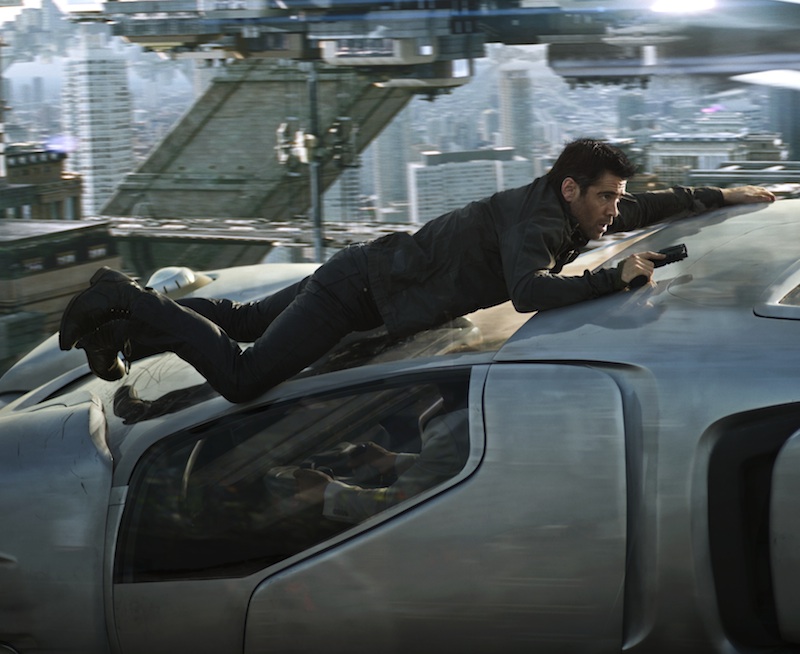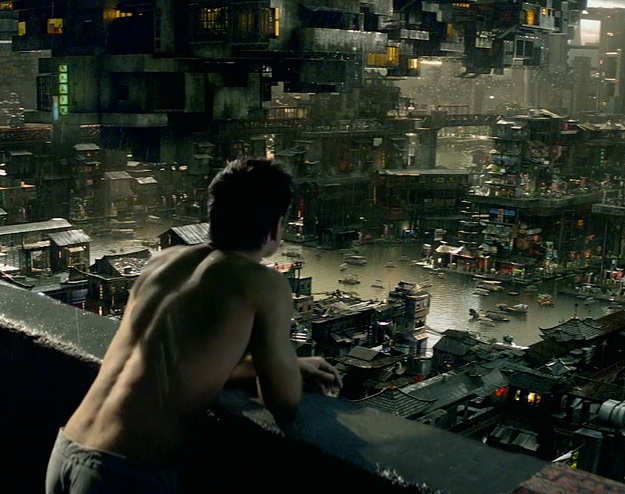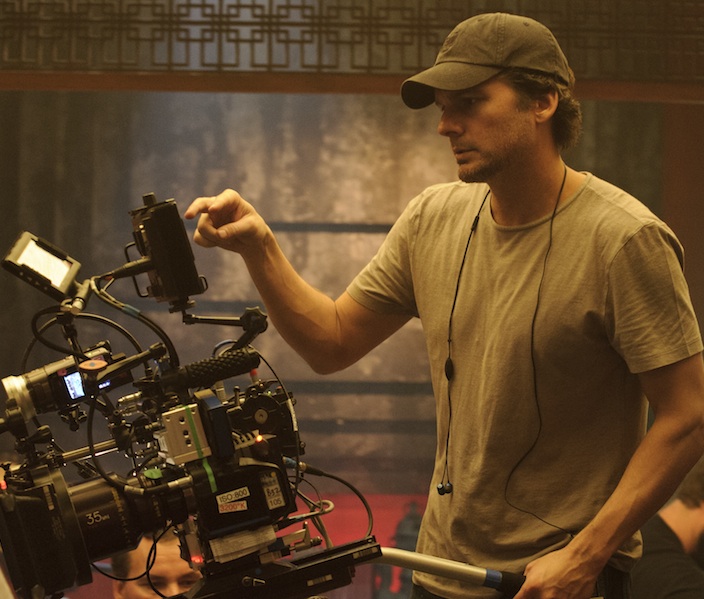“The impetus to do it was based on picking up the short story, reading it, and saying, ‘Wow, it would be great to do this.’”
The phrase “sci-fi” was rarely brought up during my visit to the set of Total Recall, the latest adaptation of Philip K. Dick’s classic short story. Director Len Wiseman didn’t want us to think of his film as a fantastical adventure in the future, or even a remake of the well-known Arnold Schwarzenegger movie from 1990. Wiseman’s Total Recall was its own entity — deconstructed and reassembled as a gritty thriller that just happens to feature hovering cars, built-in hand phones, positronic “Synth” cops and a giant elevator, China Fall, that runs from one end of the Earth to the other.  Why Wiseman doesn’t consider it a sci-fi is the human story at the center: When Douglas Quaid (Colin Farrell) attempts to fill his brain with fake memories of a life he only dreams of, he accidentally unlocks a different set of flashbacks, ones that reveal his true identity as a professional buttkicker. The original Dick is a heady piece of storytelling and Wiseman aims to maintain that — but with all the flourishes of an impeccably designed summer blockbuster.
Why Wiseman doesn’t consider it a sci-fi is the human story at the center: When Douglas Quaid (Colin Farrell) attempts to fill his brain with fake memories of a life he only dreams of, he accidentally unlocks a different set of flashbacks, ones that reveal his true identity as a professional buttkicker. The original Dick is a heady piece of storytelling and Wiseman aims to maintain that — but with all the flourishes of an impeccably designed summer blockbuster.
“There was a lot of great work done on the older movie,” explains Production Designer Patrick Tatopoulos. “The vibe and the tone of the movie is quite different in the first place. I think our approach is a little bit more like saying: you almost start the film thinking like you’re in the regular world, and then when you open your window it’s like, fuck!” Tatopoulos, who directed the third installment of Wiseman’s Underworld series, Underworld: Rise of the Lycans, as well as designing sci-fi flicks like Independence Day, Dark City and I, Robot, took great care in grounding the futuristic elements of Total Recall while attempting to differentiate them from the wealth of visual material that already existed. “Gliding cars are something that makes sense for the future. It’s acceptable to use the concept. What we had to do was try to create an infrastructure that feels different from what you saw in Minority Report or I, Robot. For example, the way you travel from one side of the world to the other, you actually travel underneath the world system. We’re going to need more space in the future, how do you compress it? Well, you travel with magnets. We all talked to futurists, just to get a sense of what the world would be tomorrow.”
Speaking to the many creatives working to deliver Total Recall, it becomes evident that the pride and joy of the crew is the future world’s central structure: China Fall, an enormous elevator that takes passengers between the sleek and expensive world of the United Federation of Britain and the bad side of the tracks planet, New Asia, where blue-collar workers like Quaid reside. Visual Effects Supervisor Adrian De Wet describes it: “It’s a cross between a 30-story building and a Saturn 5 rocket. It basically falls through to the ground. It doesn’t flip. The seating inside flips around. If you were sitting on the floor, on one side of the Earth, when you got to the other side, you’d be sitting on what used to be the ceiling, but is now the floor.” To realize this unimaginable concept, Tatopoulos consulted with scientists who helped keep reality in check. “If you take a steel ball and let it go through the Earth, it’ll take about 30 minutes,” says Tatopoulos. “We make it a trip of about 15 – 20 minutes. Basically you just go sit in there – the seats are very similar to those you’d find in an amusement park ride.” The gargantuan mechanism that stands as a towering centerpiece in both cities, is Quaid main mode of transportation when he eventually goes on the run. China Fall’s broad top, which was built on as a physical set on one of Total Recall‘s many stages, is also the setting of one of the film’s big action scenes.
With only two inhabitable areas left on Earth, land is coveted by the hungry businessman-like bad guy Cohaagen, while the societal divide figures prominently into both Total Recall‘s story and design. “We’re dealing with a more relatable class issue of haves and have nots,” says Producer Toby Jaffe.  “Classic working-class people against the wealthy who control the real estate, and want to control the real estate of the planet.” Although Total Recall takes place in an unspecified time in the future, evidence of the past and the change the world has undergone is apparent, every century leaving its mark as the city builds upwards. In the case of New Asia, its more a matter of keeping buildings standing at all. Quaid’s apartment complex and the innerworkings of New Asia were also built on a stage, tightly-packed structures reminiscent of Blade Runner‘s rainy city, all founded on an intricate series of water-filled canals. Color played an important part at creating separation between the two worlds, “We started with Chinese colors red and green [for New Asia],” explains Costume Designer Sanja Milkovic Hays. “It’s going to be, you know, different shades of red, different shades of green, bronze, gold, browns. It’s almost like autumn colors, completely different from the colors of United Britain, which are stark: clean gray, blue, white. Very cold.” But it’s not all shabby down in the world of New Asia. The future is still the future, after all. According to De Wit, Quaid’s apartment is ultra-modern with a “mid-century feel,” with a slight nod to the ’60s. “All the rooms are quite square and boxy at slightly different levels, like a half-sunk bedroom. I think one of the inspirations for that was this project in Montreal called Habitat, which, from the outside, looks like an insane collection of cubes.”
“Classic working-class people against the wealthy who control the real estate, and want to control the real estate of the planet.” Although Total Recall takes place in an unspecified time in the future, evidence of the past and the change the world has undergone is apparent, every century leaving its mark as the city builds upwards. In the case of New Asia, its more a matter of keeping buildings standing at all. Quaid’s apartment complex and the innerworkings of New Asia were also built on a stage, tightly-packed structures reminiscent of Blade Runner‘s rainy city, all founded on an intricate series of water-filled canals. Color played an important part at creating separation between the two worlds, “We started with Chinese colors red and green [for New Asia],” explains Costume Designer Sanja Milkovic Hays. “It’s going to be, you know, different shades of red, different shades of green, bronze, gold, browns. It’s almost like autumn colors, completely different from the colors of United Britain, which are stark: clean gray, blue, white. Very cold.” But it’s not all shabby down in the world of New Asia. The future is still the future, after all. According to De Wit, Quaid’s apartment is ultra-modern with a “mid-century feel,” with a slight nod to the ’60s. “All the rooms are quite square and boxy at slightly different levels, like a half-sunk bedroom. I think one of the inspirations for that was this project in Montreal called Habitat, which, from the outside, looks like an insane collection of cubes.”
While Total Recall will dig deep into futuristic design and existential concepts, there should be no lack of action during Quaid’s hunt for the truth. Teased in the film’s first trailer was Wiseman’s proudest achievement: a shot that zips around Farrell as he dukes it out with goons for the first time. Described at last year’s Comic-Con as a rig akin to NFL glide cams, de Wit reveals it’s a bit more complicated (and dangerous) than that. “It’s just a camera mount, basically, which means you can shoot the camera down it at something like 15 feet per second, which is a very high-speed move. The reason why we used this is so that we could basically have the action in the middle of the floor, and have, what looks like, a continuous camera move going around all the action. In reality, it’s up to six separate sliders with the camera mounted on it, and three separate cameras, which basically cross over at a common point, and, at the crossover point, the lenses are converged so it’s like one continuous move.” The scene was shot in only two days, but only after months of prep, as coordinating the zipping cameras took the utmost precision. “If one them hits you in the head, you could be seriously injured, so it has to be perfectly choreographed, to within the inch. All the camera guys out there were all wearing helmets.”
While we walked the massive sets of the China Fall top and New Asia, the real treat was seeing Wiseman and the actors in action, inside China Fall’s descending car. Like an Apple computer stretched across a wall, the interior of China Fall was bright white and practically constructed. Hyper-cleanliness adds to the future feel, and Wiseman is taking a cue from J.J. Abrams’ Star Trek with the addition of lens flare, which he thinks “can help make a really grungy environment seem slightly futuristic.”  Along with a scene in which Biel’s Melina rescues an incarcerated Quaid, we also saw Wiseman’s Underworld star Kate Beckinsale in action. Accompanied by a gang of cops (or robotic Synths? It could be either, thanks to the CG process which will later added to human actors), Beckinsale’s Lori makes her way to a broken China Fall window, which Quaid and Melina have escaped through. A sweet detail for sci-fi buffs will be Lori’s hand-phone, achieved through a LED light hand rig that emits a blue glow on to Beckinsale’s face. Off camera, actor Bryan Cranston dialogues with the actress, whose character takes quite the reprimanding from her boss, Cohaagen.
Along with a scene in which Biel’s Melina rescues an incarcerated Quaid, we also saw Wiseman’s Underworld star Kate Beckinsale in action. Accompanied by a gang of cops (or robotic Synths? It could be either, thanks to the CG process which will later added to human actors), Beckinsale’s Lori makes her way to a broken China Fall window, which Quaid and Melina have escaped through. A sweet detail for sci-fi buffs will be Lori’s hand-phone, achieved through a LED light hand rig that emits a blue glow on to Beckinsale’s face. Off camera, actor Bryan Cranston dialogues with the actress, whose character takes quite the reprimanding from her boss, Cohaagen.
Wiseman is packing a lot of plot and a lot of action into his version of Total Recall (we didn’t even get a glimpse of what to expect from the hovercraft chase that took him fifteen days to shoot), but he believes that his story is expansive enough in its musings to allow for more adventures in the Total Recall universe. “I’ve always thought, from the original story, there definitely is because of the nature of what this is. The movie Total Recall, or Recall itself, it’s offering an experience, a journey. Whether it be Mars, or whatever the location is. I think the nature of what the overall cool concept is does allow for that kind of that kind of thing. ” Wiseman doesn’t want to tease the audience with sequel set up, but rather, pose questions that will keep them talking after they leave the theater. “It’s not like we end with a tee-up. Really, we just want to make a good movie. We’re hoping that it ends with a feeling of great satisfaction, and posing a question to you as an audience member: What do you want to believe that this movie is? Did it really happen, or didn’t it really happen?” Wiseman takes joy in the uncertainty, and is purposefully planting details that will divide audiences. “There’s going to be a lot of speculation. I would think — I would hope! — some people are going to absolutely think one way, [other people] may think the other.”
One thing that’s 100% real? The movie. Total Recall hits theaters August 3, 2012.
Follow Matt Patches on Twitter @misterpatches
More:
Colin Farrell and Jessica Biel on ‘Total Recall’: ‘It Is F**king Huge’
‘Total Recall’: Bryan Cranston on Breaking the Mustache-Twirling Bad Guy Mold
See the Full Trailer for Colin Farrell’s ‘Total Recall’ Reboot
[Photo Credit: Sony Pictures]



